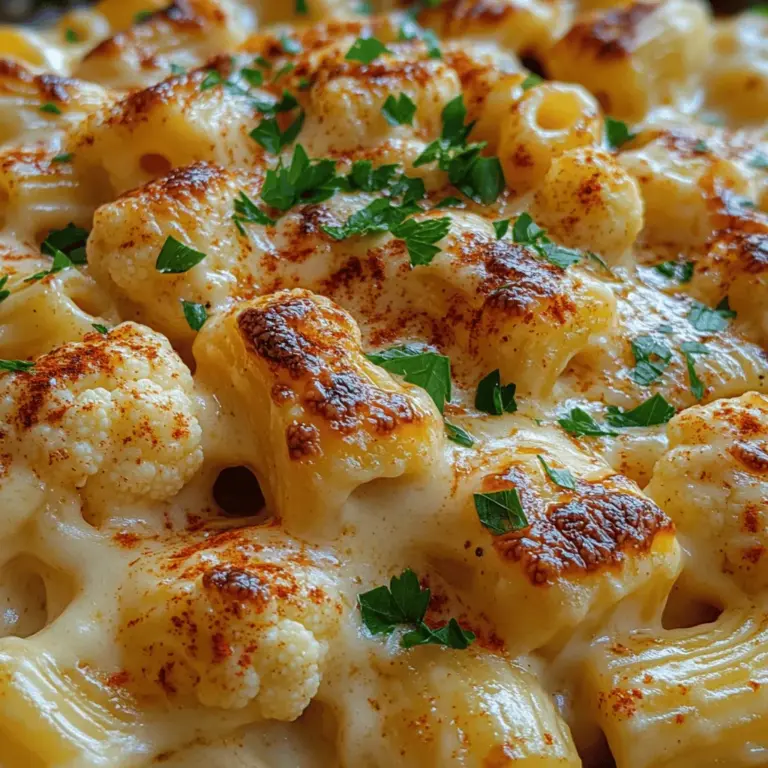Introduction to Creamy Cauliflower Mac & Cheese
In the realm of comfort food, few dishes rival the richness of mac and cheese. It’s a classic that evokes nostalgia and warmth, often bringing back memories of family gatherings and cozy dinners. However, as more people seek healthier eating habits without sacrificing flavor, this beloved dish has seen a delicious transformation. Enter Creamy Cauliflower Mac & Cheese—a delightful twist that incorporates nutrient-dense cauliflower while maintaining the creamy, cheesy goodness we all cherish. This innovative recipe not only caters to those looking to reduce their carbohydrate intake but also offers a fantastic alternative for gluten-free and dairy-free diets.
Cauliflower is a versatile vegetable that has gained popularity in the culinary world, renowned for its ability to mimic the texture of traditional ingredients. When blended into a creamy sauce, it delivers a comforting base that is both satisfying and nutritious. In this article, we will delve into the ingredients that make this dish special, explore the preparation methods that ensure a flawless outcome, and highlight the nutritional benefits of each component. You will have all the information you need to create the ultimate comfort food experience in your own kitchen.
Understanding the Ingredients
The Star Ingredient: Cauliflower
Cauliflower serves as the foundation of this dish, and it’s no wonder why. This cruciferous vegetable is packed with vitamins C, K, and B6, along with essential minerals like potassium and magnesium. It is low in calories and high in fiber, making it an excellent choice for those looking to manage their weight while still enjoying rich, flavorful meals. The high water content in cauliflower also contributes to the creamy consistency of the sauce when blended, allowing it to replicate the richness typically associated with heavy cream or cheese.
Moreover, cauliflower has a mild flavor that easily absorbs the seasonings and cheese, enhancing the overall taste of the dish. When roasted or boiled, it develops a subtle sweetness that complements the sharpness of the cheese, making it a perfect partner in this mac and cheese recipe.
The Pasta Choice: Elbow Macaroni
The traditional pasta choice for mac and cheese is elbow macaroni, primarily due to its shape, which captures the cheese sauce beautifully. However, as dietary preferences evolve, many are looking for gluten-free alternatives. Fortunately, there are numerous gluten-free pasta options available, including those made from brown rice, quinoa, or chickpeas. When selecting the best pasta for this recipe, it’s essential to consider the cooking time and texture. Look for pasta that holds its shape well after cooking and has a similar bite to traditional elbow macaroni to ensure an authentic mac and cheese experience.
For those who prefer a more nutritious option, whole grain or legume-based pasta can also be great substitutes. These options not only provide added fiber and protein but also enhance the dish’s overall nutritional profile.
Dairy and Dairy Alternatives
Creaminess is a hallmark of any mac and cheese recipe, and the choice of dairy products plays a crucial role in achieving that velvety texture. Whole milk is typically used for its rich flavor and mouthfeel, but for those following a dairy-free lifestyle, almond milk or cashew milk can be suitable alternatives. While these non-dairy options may slightly alter the flavor, they still contribute to a smooth sauce when combined with the right ingredients.
Cheese is another critical component in this dish. Sharp cheddar is often the cheese of choice due to its robust flavor that stands out against the mildness of cauliflower. Additionally, incorporating Parmesan cheese adds a nutty depth to the sauce. For those avoiding dairy, there are several vegan cheese options available that melt well and provide a similar taste profile.
Essential Seasonings and Flavor Enhancers
To elevate the flavor profile of your Creamy Cauliflower Mac & Cheese, a careful selection of seasonings is essential. Dijon mustard adds a tangy kick that balances the richness of the cheese, while garlic powder and onion powder contribute a savory depth. Smoked paprika introduces a subtle smokiness that enhances the overall complexity of the dish.
The right balance of these seasonings will transform a simple creamy sauce into a flavorful masterpiece. Adjusting the amounts according to your taste preferences can make all the difference, ensuring that each bite is as delicious as the last.
Step-by-Step Preparation Guide
Cooking the Cauliflower and Pasta
The first step in creating the perfect Creamy Cauliflower Mac & Cheese is to cook the cauliflower and pasta together. Start by bringing a large pot of salted water to a boil. Add the elbow macaroni to the boiling water and cook for about 2 minutes less than the package instructions suggest, as it will continue to cook in the oven later.
Once the pasta has cooked for the designated time, add the cauliflower florets to the pot. This method allows the cauliflower to soften while the pasta cooks, ensuring both components are ready at the same time. After about 3-5 minutes, check the cauliflower for tenderness—it should be easily pierced with a fork but not mushy. Drain the pasta and cauliflower mixture, reserving about a cup of the starchy pasta water, which will be useful later for adjusting the sauce’s consistency.
Crafting the Cheese Sauce
Now that your pasta and cauliflower are cooked, it’s time to craft the cheese sauce. Begin by making a roux, which is the foundation of many creamy sauces. In a large saucepan, melt 2 tablespoons of butter over medium heat. Once melted, whisk in 2 tablespoons of flour, stirring constantly for about 1-2 minutes until the mixture is bubbly and golden. This step is crucial as it helps to eliminate any raw flour taste.
Gradually pour in the whole milk or your chosen dairy alternative, whisking continuously to prevent lumps from forming. The key here is to add the milk slowly while maintaining a steady whisking motion. As the milk heats, it will begin to thicken. Once the sauce reaches a simmer, reduce the heat and allow it to thicken further, stirring frequently.
Seasoning and Thickening the Sauce
As your cheese sauce begins to thicken, it’s time to season it to perfection. Stir in your selected cheeses—sharp cheddar and Parmesan—until melted and smooth. Now, you can use the reserved pasta water to adjust the sauce’s consistency if it becomes too thick. Add a splash at a time until you reach your desired creaminess.
Taste your sauce and make any necessary adjustments with additional seasonings. If you feel it needs a little more tang, add a bit more Dijon mustard. For extra flavor, consider a pinch of smoked paprika or additional garlic powder. This is your chance to personalize the dish before combining it with the pasta and cauliflower.
With these foundational steps complete, you’re well on your way to creating a comforting, creamy dish that combines the best of mac and cheese with the health benefits of cauliflower. In the next section, we will explore how to bring this dish together and bake it to perfection, ensuring a cheesy and satisfying meal that everyone will love.
{{image_2}}
Incorporating the Cheese
To achieve that smooth, velvety cheese sauce that makes mac and cheese so irresistible, there are a few essential tips to follow. Start by ensuring that your cheese is at room temperature before you incorporate it into the sauce. This will help it melt more uniformly, preventing any clumping.
Tips for Achieving a Smooth, Velvety Cheese Sauce
1. Grate Your Own Cheese: Pre-packaged shredded cheese often contains anti-caking agents that can affect how well the cheese melts. Grating your cheese fresh will yield a creamier sauce.
2. Use a Combination of Cheeses: For the best flavor and texture, consider using a blend of cheeses. A mix of sharp cheddar for flavor, mozzarella for stretchiness, and cream cheese for added creaminess works wonders.
3. Slow and Steady: Gradually add the cheese to the sauce while stirring continuously over low heat. This ensures the cheese melts evenly and incorporates fully without becoming grainy.
4. Incorporate Starch: If the sauce seems too thick or clumpy, add a splash of the reserved pasta cooking water. The starch in the water helps to create a silky texture.
Recommended Cheese Brands for the Best Results
When it comes to the best cheese for your creamy cauliflower mac and cheese, here are a few brands that are known for their quality:
– Tillamook: Known for its rich, flavorful cheeses that melt beautifully.
– Cabot: Offers a great selection of sharp cheddars that provide a robust flavor.
– BelGioioso: Their fresh mozzarella adds a lovely creaminess when melted.
– Philadelphia Cream Cheese: A classic choice for adding silkiness to your sauce.
Combining the Macaroni, Cauliflower, and Sauce
Once your cheese sauce is perfectly smooth, it’s time to bring everything together. Combining the macaroni, cauliflower, and cheese sauce requires a gentle touch to avoid breaking the cauliflower florets.
Techniques for Folding Ingredients Without Breaking the Cauliflower
1. Use a Rubber Spatula: A rubber spatula allows you to fold the ingredients together gently without mashing the cauliflower.
2. Start with the Sauce: Pour a portion of the cheese sauce into the pot with the macaroni and cauliflower first. Stir gently to coat the pasta and cauliflower before adding the remaining sauce. This method helps in evenly distributing the sauce.
3. Fold, Don’t Stir: Instead of stirring vigorously, use a folding motion to combine the ingredients. This technique is essential for keeping the cauliflower intact while ensuring every piece gets coated with that creamy goodness.
Visual Cues for Knowing When the Dish is Perfectly Mixed
A well-mixed dish will have the macaroni and cauliflower evenly coated with the cheese sauce. Look for a creamy consistency where the sauce clings to the pasta without being overly runny. The cauliflower should still hold its shape, while the macaroni should be fully enveloped in that luscious cheese sauce.
Serving Suggestions and Presentation
When it comes to serving your creamy cauliflower mac and cheese, presentation can elevate the dining experience.
Ideal Serving Temperature
To enjoy the fullest flavor and creaminess, serve your mac and cheese hot. The cheese sauce is at its most luscious when warm, creating that perfect gooey texture.
Best Vessels for Serving Creamy Mac and Cheese
1. Cast Iron Skillet: For a rustic presentation, serve your dish in a cast iron skillet. It retains heat well and adds an appealing aesthetic.
2. Casserole Dish: A classic choice for family-style gatherings, a casserole dish allows for easy serving and can be placed directly on the table.
3. Individual Ramekins: For a more upscale presentation, consider serving in individual ramekins. This not only looks elegant but also allows for portion control.
Garnishing for Visual Appeal
Adding a garnish can enhance both the flavor and appearance of your dish.
1. Fresh Parsley: A sprinkle of freshly chopped parsley adds a pop of color and a hint of freshness that contrasts beautifully with the rich cheese sauce.
2. Breadcrumb Topping: Toasted breadcrumbs mixed with a little olive oil can be sprinkled on top before serving. This adds a delightful crunch that complements the creamy texture.
3. Chili Flakes: For those who enjoy a bit of heat, a sprinkle of red chili flakes elevates the flavor profile and adds visual interest.
Nutritional Analysis of Creamy Cauliflower Mac & Cheese
When indulging in comfort food, understanding its nutritional profile can help you make informed choices.
Caloric Breakdown
A serving of creamy cauliflower mac and cheese typically contains around 350-450 calories, depending on the specific cheeses and portion sizes used. This is significantly lower than traditional mac and cheese, which can range from 600-800 calories per serving.
Comparison with Traditional Mac and Cheese
By substituting cauliflower for a portion of the pasta, you not only reduce calories but also increase the nutritional value. Cauliflower is low in carbs and high in fiber, making it a healthy alternative that doesn’t compromise on taste.
Health Benefits of Ingredients
1. Cauliflower: This cruciferous vegetable is rich in vitamins C and K and provides antioxidants that support overall health. It’s also a low-calorie food that can aid in weight management.
2. Whole vs. Almond Milk: Using whole milk provides a creamier texture, while almond milk can reduce calories and fat content. Almond milk is also lactose-free, making it suitable for those with dairy intolerances.
Dietary Considerations
For those with dietary restrictions, creamy cauliflower mac and cheese can be easily adapted.
Gluten-Free and Dairy-Free Variations: How to Adapt the Recipe
– Gluten-Free: Use gluten-free pasta made from brown rice or chickpeas. This allows those with gluten sensitivities to enjoy the dish without sacrificing flavor.
– Dairy-Free: Utilize vegan cheese or nutritional yeast in place of traditional cheese. Nutritional yeast adds a cheesy flavor while keeping the dish plant-based.
Balancing Indulgence with Nutrition
While creamy cauliflower mac and cheese is a comforting dish, it can also be a nutritious choice. Incorporating more vegetables and reducing cheese can help balance indulgence with health benefits, making it a perfect meal for any day of the week.
Conclusion: A Healthier Comfort Food Classic
Creamy cauliflower mac and cheese offers a delightful balance of taste and nutrition, allowing you to indulge in a classic comfort food without the guilt. With its creamy texture and rich flavors, this dish is sure to impress both family and friends. Whether you’re looking to make a quick weeknight meal or a crowd-pleaser for gatherings, this recipe stands out as a versatile and satisfying option. Enjoy the wholesome goodness of cauliflower and the comfort of cheese in every bite, making it a staple in your culinary repertoire. Embrace the comforting flavors and textures of this dish, and make it a regular feature at your dining table.



